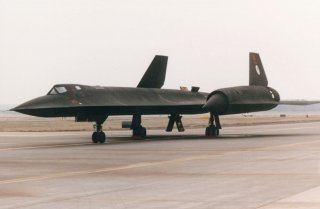Meet the Only SR-71C Ever Produced: A Cross Between a YF-12 and Half SR-71
Fascinating.
The aircraft made its last flight on Apr. 11, 1976 and was removed from flying status on Jun. 24, 1976 with only 556.4 flight hours, not including the 180.9 hours accumulated on the aircraft as YF-12A S/N 60-6934.
Taken at Hill Air Force Base (AFB) in June 2016, the interesting clip in this post shows SR-71C, “The Bastard” S/N 61-7981, that was the only C model Blackbird ever built and was the last SR-71 to be manufactured. It was nicknamed “The Bastard” since it was a hybrid comprised of the rear fuselage of the first YF-12A(S/N 60-6934) and a functional engineering mockup of an SR-71A forward fuselage built for static testing.
The plane was built to replace the second of the two B model trainers after it crashed on Jan. 11, 1968. The C model made its first flight on Mar. 14, 1969 from the Lockheed plant at Palmdale, California, with Blackbird Chief Project Pilot Robert J. Gilliland at the controls and Lockheed test pilot Steve Belgeau as Reconnaissance Systems Officer. After flight testing it was delivered to the 9th Strategic Reconnaissance Wing at Beale AFB, California, on Sep. 3, 1970.
The aircraft made its last flight on Apr. 11, 1976 and was removed from flying status on Jun. 24, 1976 with only 556.4 flight hours, not including the 180.9 hours accumulated on the aircraft as YF-12A S/N 60-6934. It was then processed for long-term storage at the Lockheed plant in Palmdale, California.
Through the intervention of Utah Senator Orrin G. Hatch, Hill Aerospace Museum was assigned the aircraft by the Air Force in April 1990 and immediately began planning its relocation from Beale AFB to Hill AFB.
Representatives from the museum, the Air Force Heritage Foundation of Utah, the 67th Aerial Port Squadron, and the 405th Combat Logistics Support Squadron (CLSS) traveled to California in July 1990 to determine the best way to disassemble, package, and transport the aircraft.
Then a sixteen-member team from the 405th CLSS went to California in August 1990 and broke the aircraft down into three major pieces and assorted smaller components, including a J58 engine and start cart, palletizing them all for transport on a C-5 Galaxy cargo aircraft. However, when the disassembly operation was completed no cargo aircraft was immediately available to transport the pieces back to the base. Everything would have to wait.
In the Spring of 1991 representatives from the 67th Aerial Port Squadron and the 405th CLSS traveled twice to Beale AFB via two large, flat-bed trucks to retrieve most of the palletized components, leaving only the largest pieces that would require transport by cargo aircraft. In August 1991, one year after the disassembly had begun, air transport was finally arranged via a C-5 from Travis AFB.
Once all the pieces were finally on base, the aircraft components were gathered together in a large hangar belonging to the 405th CLSS for reassembly and restoration. Volunteers, Air Force Reservists, and many active-duty personnel were involved in the intricate two-month process of piecing the aircraft back together. On Oct. 16, 1991 the completed aircraft was towed to the museum and placed on display.
This article by Dario Leone originally appeared on The Aviation Geek Club in 2018.
Image: Smithsonian National Air and Space Museum

